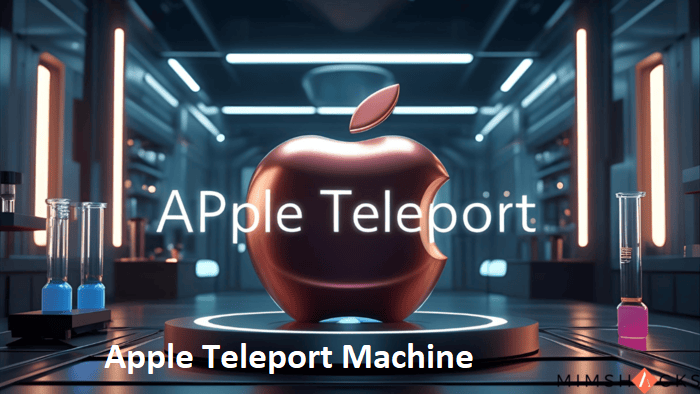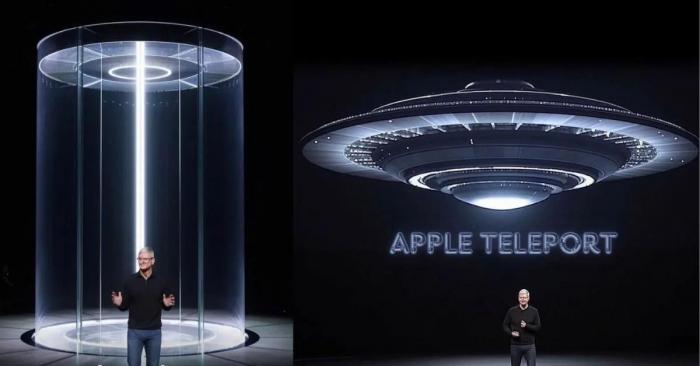Apple Teleport Machine: A Futuristic Leap into Instant Travel

Introduction: Apple’s Bold Move into Teleportation
Apple Teleport Machine When Apple makes headlines, it’s usually for a new iPhone or a groundbreaking update to its ecosystem. But the recent buzz around the so-called Apple Teleport Machine takes things to an entirely new level. Imagine stepping into a sleek, glass-encased booth, selecting your destination on an Apple interface, and reappearing across the globe—or even on another continent—within seconds. It sounds like science fiction, yet Apple’s rumored venture into teleportation technology has ignited both excitement and skepticism across the tech world.
The idea of instant travel has captivated humans for centuries. From Star Trek’s transporters to countless sci-fi novels, teleportation has long been a dream. Now, if the whispers from Cupertino are to be believed, Apple aims to transform that dream into a tangible product. This is not just another gadget release—it’s a potential redefinition of human mobility and global connectivity.
Of course, such an ambitious concept doesn’t come without questions. How would it work? Is it even scientifically feasible? And what would it mean for industries like aviation, shipping, or even real estate? To understand the implications, we need to explore the potential technology, societal impact, and the challenges Apple might face in making the Apple Teleport Machine a reality.
The Vision Behind the Apple Teleport Machine

Apple Teleport Machine has always positioned itself as more than just a tech company; it’s a lifestyle innovator. From revolutionizing music with the iPod to reshaping communication with the iPhone, Apple thrives on making the once-impossible seem natural. The Apple Teleport Machine fits perfectly into this tradition. It promises to eliminate geographical barriers, making distances irrelevant and travel instantaneous.
Imagine planning a meeting in Tokyo while sipping coffee in New York and simply “teleporting” to your destination minutes before it begins. Apple’s design philosophy—minimalism combined with cutting-edge engineering—would undoubtedly turn such a complex technology into a user-friendly experience. A seamless interface linked to Apple ID could make teleportation as simple as sending a text.
More than convenience, the Apple Teleport Machine speaks to Apple’s broader mission: reducing friction in how humans connect and experience the world. Just as the iPhone placed the internet in our pockets, teleportation could place the entire planet within arm’s reach. It’s not merely a product; it’s a bold statement about the future of human mobility.
The Science of Teleportation: From Fiction to Feasible
To the average person, teleportation sounds like magic. But in scientific circles, the concept has been explored for decades—albeit on a microscopic scale. Quantum teleportation, a real phenomenon demonstrated in physics labs, involves transmitting information about the state of particles across distances. Apple’s rumored teleport machine would need to scale this idea to human-sized objects, which is a monumental challenge.
The theoretical process might involve disassembling matter at the atomic level, transmitting its quantum information to another location, and reassembling it perfectly. Apple would need to integrate breakthroughs in quantum computing, molecular reconstruction, and energy transfer—fields still in their infancy. The power requirements alone would dwarf anything currently imaginable for consumer electronics.
Still, Apple has a history of commercializing emerging technologies ahead of competitors. Their expertise in hardware-software integration and their investments in quantum computing research could give them a unique advantage. While the Apple Teleport Machine may not be around the corner, it’s not entirely outside the realm of future possibility.
Impact on Global Travel and Transportation
If Apple succeeds, the consequences for global transportation would be seismic. Airlines, shipping companies, and even automobile manufacturers would face an existential crisis. Why book a 12-hour flight when you could simply teleport? Cargo and freight could be moved instantly, revolutionizing supply chains and reshaping the global economy.
Tourism, too, would experience a renaissance. People could visit multiple countries in a single day, erasing the time constraints that limit travel today. Remote regions could suddenly become accessible to millions, potentially boosting local economies. Business travel would become nearly instantaneous, creating opportunities for cross-border collaboration that were previously unimaginable.
However, such convenience might also create new challenges. Immigration policies, customs regulations, and national security would need to be rethought. Governments worldwide would have to grapple with controlling the movement of people and goods when travel happens at the speed of light. The Apple Teleport Machine wouldn’t just disrupt industries; it would force a complete reimagining of how nations manage borders and trade.
Economic and Environmental Implications
The economic ripple effects of teleportation could be staggering. Airlines and shipping giants might collapse, while new markets—like teleportation hubs and instant-delivery services—would emerge. Real estate values could shift dramatically, as people would no longer be tied to living near their workplaces or major cities. Small towns and rural areas might see a revival as teleportation removes the barriers of distance.
From an environmental perspective, the Apple Teleport Machine could be both a blessing and a challenge. On one hand, it could drastically reduce the carbon footprint of global transportation, slashing greenhouse gas emissions from planes, cars, and cargo ships. On the other hand, the energy demands of teleportation could be immense, requiring breakthroughs in clean and sustainable power sources to prevent trading one environmental crisis for another.
Apple, known for its focus on sustainability, would likely emphasize renewable energy solutions. The company’s existing investments in solar and wind power could form the backbone of a teleportation infrastructure that is both efficient and environmentally responsible. But scaling such technology to a planetary level would be a task of unprecedented complexity.
Ethical, Legal, and Security Challenges
With great technological leaps come equally great ethical dilemmas. Teleportation raises profound questions about identity, privacy, and security. Would a teleported person be the same individual, or merely an identical copy? Philosophers and scientists alike have debated the implications of disassembling and reassembling human matter.
Data privacy would also become a critical issue. Teleportation requires transmitting vast amounts of personal biological data, creating new risks of hacking or misuse. Apple’s reputation for strong encryption and user privacy could give it an edge, but the stakes would be higher than ever. A single breach could have catastrophic consequences.
Legal systems worldwide would need to adapt as well. Laws governing passports, customs, and even criminal jurisdiction would be challenged. Governments would have to collaborate on a global framework to regulate teleportation, ensuring that the Apple Teleport Machine doesn’t become a tool for smuggling, espionage, or unauthorized movement.
The Road Ahead: From Concept to Reality
Despite the excitement, it’s important to remember that the Apple Teleport Machine remains speculative. Even with Apple’s resources, the path to functional human teleportation is long and uncertain. Quantum computing must advance significantly, energy production must scale dramatically, and regulatory frameworks must evolve to accommodate such disruptive technology.
Yet, history has shown that what seems impossible today often becomes commonplace tomorrow. Smartphones, the internet, and even electric cars were once dismissed as far-fetched ideas. Apple has repeatedly demonstrated the ability to turn ambitious visions into everyday tools, and teleportation could be its most daring challenge yet.
For now, the Apple Teleport Machine remains a tantalizing concept—a glimpse into a future where distance no longer defines human connection. Whether it takes decades or an entire century, the dream of instant travel will continue to inspire scientists, entrepreneurs, and visionaries alike. If any company has the audacity and the resources to bring teleportation into reality, Apple just might be the one to lead the charge.
Conclusion: A Future Without Distance
The concept of the Apple Teleport Machine is more than just an exciting rumor—it’s a window into humanity’s deepest aspirations. To transcend distance, to connect instantly, and to explore without limits are desires as old as civilization itself. Apple’s rumored leap into teleportation embodies that timeless ambition.
While the technological, ethical, and legal hurdles are enormous, the potential rewards are equally breathtaking. From revolutionizing travel and commerce to reshaping the very fabric of society, teleportation could be the defining innovation of the next century.
Whether or not Apple delivers on this bold vision in our lifetimes, the mere possibility challenges us to rethink what is achievable. The Apple Teleport Machine may still be a dream, but it’s one that captures the very spirit of innovation—daring us to imagine a world where distance is no longer a barrier to human connection.
ChatGPT can make mistakes. Check important info.



